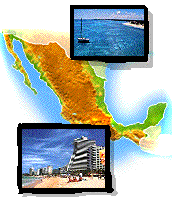
MEXICO
An Introduction
They say that Mexico is a country
no one ever leaves. Every year, millions of tourists pass through, and
Mexicans jovially warn that a part of them will remain behind forever. Most visitors
are vacationing North Americans who wind up on the brilliant beaches of
Cancun, Acapulco, Mazatlan, and Puerto Vallarta. The beaches, of course,
are among the world's best - but those who venture inland are rewarded
with the true soul of Mexico, which has always resided firmly in the interior.
part of them will remain behind forever. Most visitors
are vacationing North Americans who wind up on the brilliant beaches of
Cancun, Acapulco, Mazatlan, and Puerto Vallarta. The beaches, of course,
are among the world's best - but those who venture inland are rewarded
with the true soul of Mexico, which has always resided firmly in the interior.
And it is a big soul. The Republic of Mexico is vast, comprising nearly two million
square miles of coastline, desert, rain forest, mountains, and fertile plains.
From the American borderlands of the wide, agriculturally rich north, the country
narrows gently as it sweeps south and east. The two main mountain ranges, the
Sierra Madre Occidental and the Sierra Madre Oriental, hug the west and east,
finally merging into the volcanically active central highlands and the capital,
Mexico City - the most populous city in the world. Further south, the country
narrows to only 100 miles, then broadens again before reaching the Guatemalan
border. There are two major peninsulas in Mexico that are almost countries themselves.
In the west is the poetically barren Baja Peninsula, which seals in the biological
riches of the Sea of Cortes; to the east, portruding into the Caribbean like
the end of a fish hook, is the Yucatan peninsula, bursting with rain forests,
Mayan ruins, and white powder beaches.
The population is about 106 million, and the
generosity of the Mexican people is unsurpassed. Knowing a few simple
sentences in Spanish will win hearts.
Mexico has been graced with an unusually temperate climate year-round. The most
important thing to remember is that the Mexican summer is also the rainy season,
although the rain rarely lasts more than a few hours, and typically arrives in
the late afternoon. Extremes are present only in the North and in Baja, both
of which have deserts where the temperature leaps above 100F. Mexico City has
a year-round temperature in the high 80s, while the coasts usually stay in the
mid-90s. Night time temperatures fall somewhat, but rarely break down below a
comfortable 60F.
Copyright (c) 1998-2008 interKnowledge Corp. All rights reserved.
